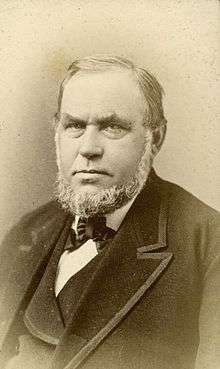Harrison Ludington
| Harrison Ludington | |
|---|---|
 Harrison Ludington | |
| 13th Governor of Wisconsin | |
|
In office January 3, 1876 – January 7, 1878 | |
| Lieutenant | Charles D. Parker |
| Preceded by | William Robert Taylor |
| Succeeded by | William E. Smith |
| 20th Mayor of Milwaukee | |
|
In office 1871–1872 | |
| Preceded by | Joseph Phillips |
| Succeeded by | David G. Hecker |
| 22nd Mayor of Milwaukee | |
|
In office 1873–1876 | |
| Preceded by | David G. Hecker |
| Succeeded by | Ammi R. Butler |
| Personal details | |
| Born |
July 30, 1812 Kent, New York |
| Died |
June 17, 1891 (aged 78) Milwaukee, Wisconsin |
| Political party | Republican |
| Spouse(s) | E. Macy Tobey |
| Profession | businessman, politician |
Harrison Ludington (July 30, 1812 – June 17, 1891) was an American Republican politician who served as the 13th Governor of Wisconsin and a mayor of Milwaukee, Wisconsin.[1]
Ancestry
Harrison Ludington descended from William Ludington, one of the earliest American colonists, who settled at Charlestown, Mass. in 1632, and died at the East Haven Iron Works, Connecticut, in 1662 or 1663.[2] His grandfather was Colonel Henry Ludington (May 25, 1739 Branford, New Haven, CT – January 24, 1817 Patterson, Putnam. NY),[3] a commanding officer of the volunteer 7th Regiment of the Dutchess County Militia, during the American Revolutionary War. Henry Ludington later became an aide to General George Washington. Henry's daughter, Sybil Ludington (1761–1839), was famous for risking her life when she was 16 years old to warn the American militia that British troops were burning Danbury, Connecticut.[4]
Biography
Ludington was born in Kent, Dutchess County, New York. Son of Frederick and Susannah (Griffeth) Ludington. Harrison received common (district) school education.[5] He moved to Milwaukee in 1838. At the age of 24 he became a joint owner of a merchandising business with his uncle, Lewis Ludington. This general merchandising business was conducted out of Solomon Juneau's warehouse between years 1839–1851.[6] In 1851 he became involved in lumber business, operating in the northeastern part of the state. He was a member of the firm of Ludington, Wells (Daniel Wells, Jr.) and Van Schaick (Anthony G. Van Schaick). Ludington became an active developer in Milwaukee, where he began his political career. He served two terms as a Milwaukee alderman, three terms as Milwaukee's mayor, a position that he resigned from to serve as Wisconsin's governor. He defeated his predecessor William R. Taylor, Democrat, in November, 1875.[7] Ludington served as a governor of Wisconsin from 1876 to 1878.[8] He married twice, his first wife was Frances White, married on March 25, 1838 in Louisville, KY. His second wife was a widow Eve Mary Tobey, they married on June 7, 1875.[9] He had a total of six children.
Governor
In his capacity as governor, Harrison Ludington facilitated promotion of commercial activity. He also undid changes in the financial sector made by his predecessor. He stood against state regulation of railroads. Under his administration the infamous Potter law was repealed, which was supposed to drastically increase government intervention in the railroad business. He also replaced the railroad commission, made up of three members with powers of establishing rates for the railroads, by a single commissioner who lacked such authority.[10] Ludington declined renomination for the position of governor in 1879 due to pressure from younger members of the Republican party.[11]
Retirement
Following his decision not to pursue renomination for governorship, Ludington resigned from public affairs and devoted himself to conducting business. German-American artist Conrad W. Heyd painted his portrait in this period of his life.[12]
Ludington died on June 17, 1891 in Milwaukee and is interred in Forest Home Cemetery there.[13]
References
- ↑ http://www.wisconsinhistory.org/dictionary/index.asp?action=view&term_id=2688&keyword=ludington
- ↑ http://familytreemaker.genealogy.com/users/d/e/a/Robert-O-Dean/GENE6-0022.html
- ↑ http://freepages.genealogy.rootsweb.ancestry.com/~dav4is/ODTs/LUDINGTON.shtml#~LUDINGTON
- ↑ http://www.historicpatterson.org/Exhibits/ExhSybilLudington.php
- ↑ http://familytreemaker.genealogy.com/users/d/e/a/Robert-O-Dean/GENE6-0022.html
- ↑ http://www.wisconsinhistory.org/museum/collections/online/Detlobjps.cfm?ObjectID=58171
- ↑ http://www.wisconsinhistory.org/museum/collections/online/Detlobjps.cfm?ObjectID=58171
- ↑ http://www.findagrave.com/cgi-bin/fg.cgi?page=gr&GRid=6854510
- ↑ http://familytreemaker.genealogy.com/users/d/e/a/Robert-O-Dean/GENE6-0022.html
- ↑ http://www.wisconsinhistory.org/museum/collections/online/Detlobjps.cfm?ObjectID=58171
- ↑ http://www.nga.org/portal/site/nga/menuitem.29fab9fb4add37305ddcbeeb501010a0/?vgnextoid=bb043c38f9177010VgnVCM1000001a01010aRCRD
- ↑ http://www.wisconsinhistory.org/museum/collections/online/Detlobjps.cfm?ObjectID=58171
- ↑ "Historical People". Forest Home Cemetery. Retrieved May 16, 2014.
External links
| Wikimedia Commons has media related to Harrison Ludington. |
| Political offices | ||
|---|---|---|
| Preceded by Joseph Phillips |
Mayor of Milwaukee 1871–1872 |
Succeeded by David G. Hooker |
| Preceded by David G. Hooker |
Mayor of Milwaukee 1873–1876 |
Succeeded by Ammi R. Butler |
| Preceded by William R. Taylor |
Governor of Wisconsin 1876–1878 |
Succeeded by William E. Smith |
